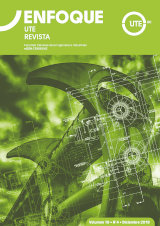Efecto del porcentaje de relleno en la resistencia a la tracción en la impresión de escritorio 3D para diferentes patrones de impresión, utilizando un diseño aleatorio de experimentos
DOI:
https://doi.org/10.29019/enfoque.v10n4.503Palabras clave:
Impresión 3D; Porcentaje de relleno; Patrón de relleno; PLA; Tensión.Resumen
La evaluación de la resistencia a la tracción de las piezas impresas mediante el modelado por deposición fundida (FDM) o la fabricación de filamentos fundidos (FFF) es esencial, ya que se pueden obtener piezas cuya resistencia no difiere significativamente dependiendo del porcentaje de relleno utilizado, optimizando el uso del material. El presente trabajo detalla el análisis de muestras de ácido poliláctico (PLA) fabricadas de acuerdo con ASTM D 638 con diferentes porcentajes para los patrones de relleno más comúnmente utilizados (Panal, Octagrama, Estrellas, Archimedean, Hilbert y Triángulos). Con la ayuda de un análisis de varianza y un diseño de experimentos con un solo factor se obtienen los porcentajes apropiados para imprimir piezas de acuerdo con el patrón de llenado deseado.
Metrics
Descargas
Citas
ASTM D3039. (2008). Standard test method for tensile properties of polymer matrix composite materials. ASTM International, West Conshohocken, PA. doi: 10.1520/D3039_D3039M-17
ASTM D638-14. (2014). Standard test method for tensile properties of plastics. ASTM International, West Conshohocken, PA. doi: 10.1520/D0638-14
ALLEVI. (2014). Infill Options on Slic3r. Recuperado de https://allevi3d.com/build-with-life/infill-slic3r (accedido el 09/07/2019).
Castillo, E., Loor, O., Muñoz, C., Naranjo, C., Padrón, D., y Peralta, D. (2016). Diseño y construcción de una máquina para ensayos de tracción. p.6. Quito, Ecuador: Universidad Internacional del Ecuador
Cazañas, A., De San Miguel, A. y Parra, E. (2017). Estimación del tamaño de la muestra para pruebas de usabilidad. Quito, Ecuador. Enfoque UTE, 7(1), 172-185.
Díaz Abad, J. (2016). Bioprinting: el mundo del 3D en la medicina. (Documento electrónico). Elsevier. Recuperado de https://www.elsevier.com/es-es/connect/ciencia/bioprinting-el-mundo-del-3d-en-la-medicina (accedido el 08/07/2019).
Escobar, J., y Escobar, R. (2018). Determinación de la velocidad óptima para la soldadura MIG de la aleación 5086-H116, mediante ensayo de dureza, prueba de tracción y examen metalográfico para la fabricación de tanqueros de aluminio. Enfoque UTE, 9(3), 42-49.
ESUN. (2007). Product and Services. (Documento electrónico). Recuperado de http://www.esun3d.net/Products/PLA (accedido el 09/07/2019).
Fernandez, M., Calle, W., Ferrandiz, S. y Conejero, A. (2016). Effect of Infill Parameters on Tensile Mechanical Behavior in Desktop 3D Printing. 3D Printing and Additive Manufacturing, 3(3). doi: 10.1089/3dp.2015.0036
González, J. (2009) Manual Básico SPSS. Talca, Chile: Centro de Inserción Laboral Programa Jóvenes Profesionales.
Haid C. (2014). Characterizing Tensile Loading Responses of 3D Printed Samples. Massachusetts , EE.UU.: Massachusetts Institute of Technology, 38-40.
Juiña, L., Cabrera, V., y Reina, S. (2017). Aplicación de la teoría de restricciones en la implementación de un Sistema de Manufactura CAD-CAM en la industria Metalmecánica-Plástica, Caso de estudio Quito, Ecuador. Enfoque UTE, 8(3), 56-71.
Pérez, M (2014). Diseño de experimentos. Aplicaciones con IBM SPSS. Createspace Independent Publishing Platform.
Pulido, H. G., De la Vara Salazar, R., González, P. G., Martínez, C. T., & Pérez, M. D. C. T. (2012). Análisis y diseño de experimentos. New York, EE.UU.: McGraw-Hill.
Molina, R., Pender, G., Moro, L., y Piovan, M. (2018). Comportamiento al creep de un polímero utilizado para impresión 3D. Revista Materia, 23(2).
Montgomery D.C. (2004). Diseño y Análisis de Experimentos. 2da edición. Arizona, EE.UU.: Universidad Estatal de Arizona.
Navas, A., Reyes, R. y Galván, L. (2015). Impactos ambientales asociados con el proceso de producción del concreto. Enfoque UTE, 6(4), 67-80.
Ordoñez-Alemán, G. (2017). La contribución al emprendimiento ecuatoriano de una empresa de tecnología 3D. Revista de Negocios y PYMES 2017. 3-7:35-46.
Tamayo, I., Pazmiño, L., Galván, M. y Batista, M. (2015). Implementación de prácticas de laboratorio con costo mínimo. Quito, Ecuador. Enfoque UTE, 6(2), 44-58.
Wittbrodt B. y Pearce J.M., (2015) The Effects of PLA Color on Material Properties of 3-D Printed Components. Additive Manufacturing, 8(1), 110-116
Publicado
Cómo citar
Número
Sección
Derechos de autor 2019 Enfoque UTE

Esta obra está bajo licencia Creative Commons Attribution 3.0 International License.
Los artículos e investigaciones publicadas por la Universidad UTE, se realizan en régimen de Acceso Abierto [Open Access] en formato electrónico. Al enviar un artículo a cualquiera de las revistas científicas de la Universidad UTE, el o los autores aceptan estas condiciones.
La UTE aplica la licencia Creative Commons Attribution (CC-BY) a los artículos de sus revistas científicas. En virtud de esta licencia de acceso abierto, como autor usted acuerda que cualquier persona puede reutilizar su artículo en su totalidad o en parte para cualquier propósito, de forma gratuita, incluso para fines comerciales. Cualquiera puede copiar, distribuir o reutilizar el contenido siempre y cuando el autor y la fuente original estén correctamente citados. Esto facilita la libertad de reutilización y también asegura que el contenido pueda ser extraído sin barreras para necesidades de investigación.
Esta obra está bajo una Creative Commons Attribution 3.0 International (CC BY 3.0).
Además, la Revista Enfoque UTE garantiza y declara que los autores conservan siempre todos los derechos de autor y de publicación de sus obras originales sin restricciones [© Los Autores]. El reconocimiento (BY) permite cualquier explotación de la obra, incluyendo una finalidad comercial, así como la creación de obras derivadas, la distribución de las cuales también está permitida sin ninguna restricción.























 Enfoque UTE - Facultad de Ciencias de la Ingeniería e Industrias - Universidad UTE
Enfoque UTE - Facultad de Ciencias de la Ingeniería e Industrias - Universidad UTE